“Sea Point” is the name of a suburb of Cape Town, South Africa. It lies along the Atlantic coast south of the Waterfront area, which is itself west of the main part of town, the “City Bowl.” Erosion of the land by the pounding waves of the ocean has revealed there an extraordinary outcrop of rock which figures prominently into the history of geology: the Sea Point Migmatite. This is an injection migmatite (not to be confused with an anatectic migmatite where the felsic magma derives from partial melting of the migmatite source rock). In an injection migmatite, a body of magma from somewhere else comes along and pokes its way into another body of rock. In this case, the intruder is the Cape Granite (540 Ma) and the intruded is sedimentary strata of the Malmesbury Group (~700 Ma).
Here it is:

This outcrop was visited by Charles Darwin in 1836, towards the end of his round-the-world sojourn on the H.M.S. Beagle. Darwin was aware of a controversy among early geologists as to the origins of rocks like granite and basalt: were they of igneous origin (that is, cooled from molten rock), or were they of sedimentary origin (precipitated from sea water)? This conflict is encapsulated by two schools of thought named for how they thought granites and the like formed: the plutonists favored the igneous interpretation, while the neptunists intepreted the rocks as marine deposits.
Darwin was preceded at Sea Point by Royal Navy Captain Basil Hall, who walked these same seaside outcrops and reported on them in 1812 and 1813. But Darwin’s cache as a scientific celebrity lends special importance to these rocks, even through the controversy was pretty much settled (in the plutonists’ favor) by the 1830s when Darwin visited, largely due to the influence of Charles Lyell, the man who wrote the definitive account of geology, his text Principles of Geology, a tome which Darwin had read cover to cover by the time the Beagle docked in Cape Town. With Lyell’s theory providing a framework and Hall’s plutonist interpretation of the specific outcrop as precedent, Darwin strolled this same rocky shore, and interpreted the rocks as having formed due to the intrusion of magma. He was particularly struck by the presence of xenoliths (inclusions) of the Malmesbury sediments in the granite, an example of relative dating by the principle of inclusions (Also expressed as: you can’t make raisin bread unless the raisins already exist!).
Here’s a plaque marking the location with a geologic map:
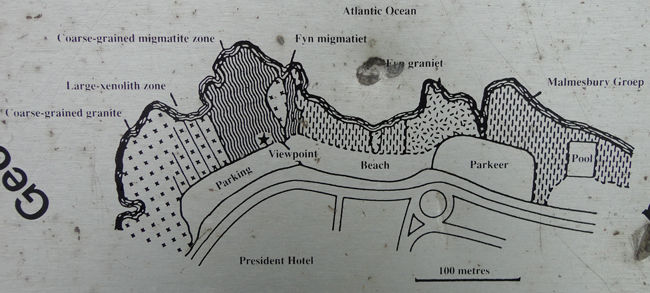
And the accompanying verbiage:
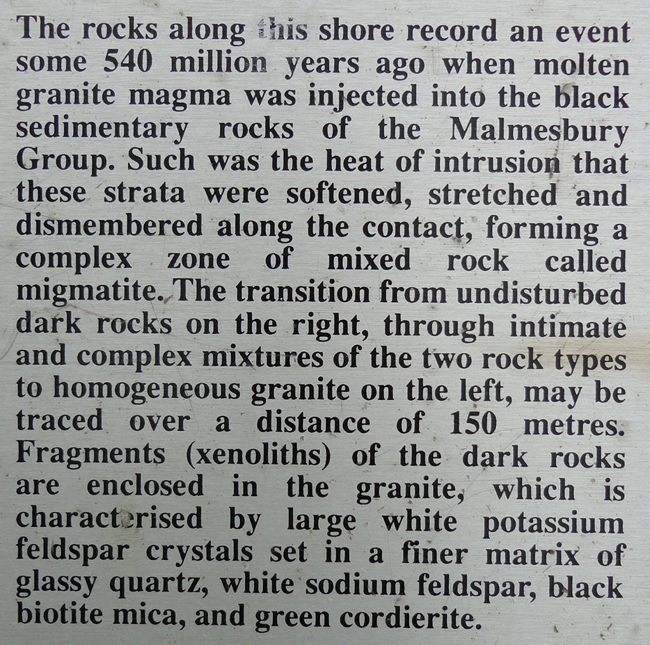
My wife Lily and I visited Sea Point in the company of fellow AGU Blogosphere contributor Evelyn Mervine and her husband Jackie Gauntlett, when we flew into Cape Town in December. They have a habit of bringing out-of-towners to this spot to show off the rocks. Chris Rowan of the blog Highly Allochthonous has been there too, and offers a direct snippet of Darwin’s description in this post from his post-doc days in South Africa.
One thing that caught Darwin’s eye and mine too was the abundance of xenoliths of Malmesbury group meta-sedimentary rock “floating” in the granite. Aided by the rotation of the layering in these xenoliths, it’s easy to imagine the process of stoping, of blocks of old rock popping off & tumbling about in the young, fresh magma.

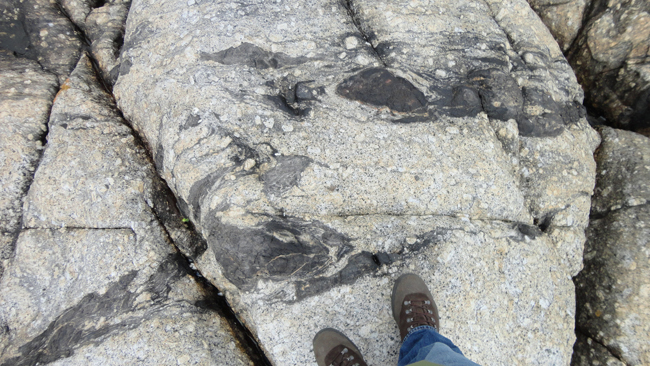
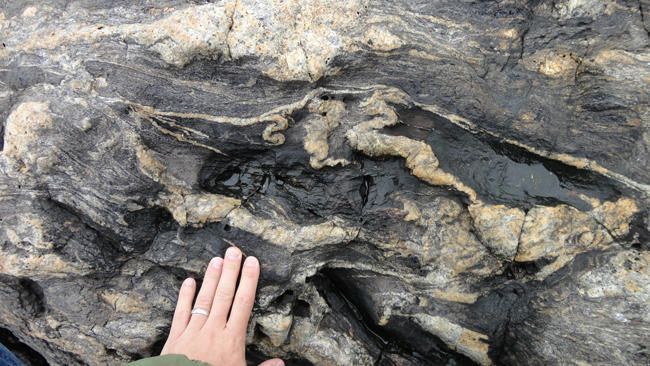

Note the chunky “megacrysts” of potassium feldspar:
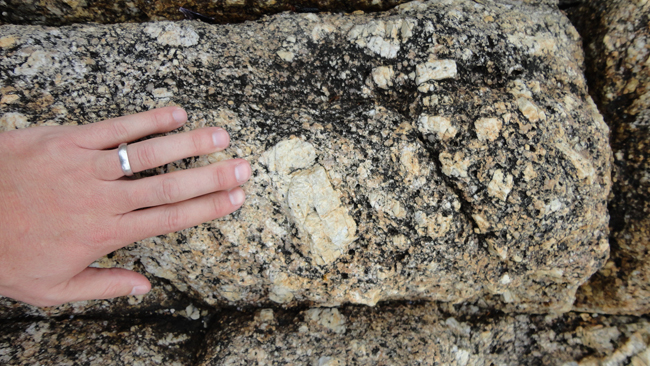
Jackie’s car keys for scale in the next two…
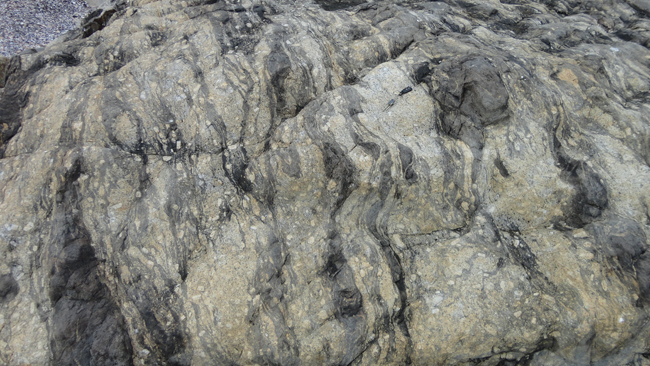
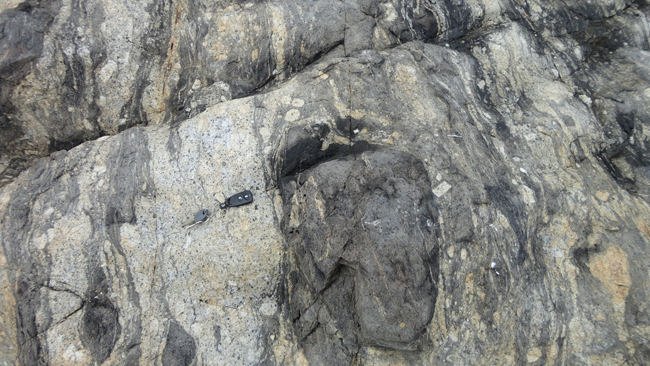
Further up the beach to the north, different compositions of Malmesbury Group are present, less intruded by granite, but cross-cut by veins of quartz, as we see here:

Awesome to gaze upon the same outcrops as Charles Darwin did, and ponder the same processes!
Thanks so much to Evelyn and Jackie for bringing us there! And thanks doubly to Jackie for putting up yet again with the tourists wanting to see the penguins in Simon’s Town. That’s where we went next (note all the granite under those penguins’ feet!).
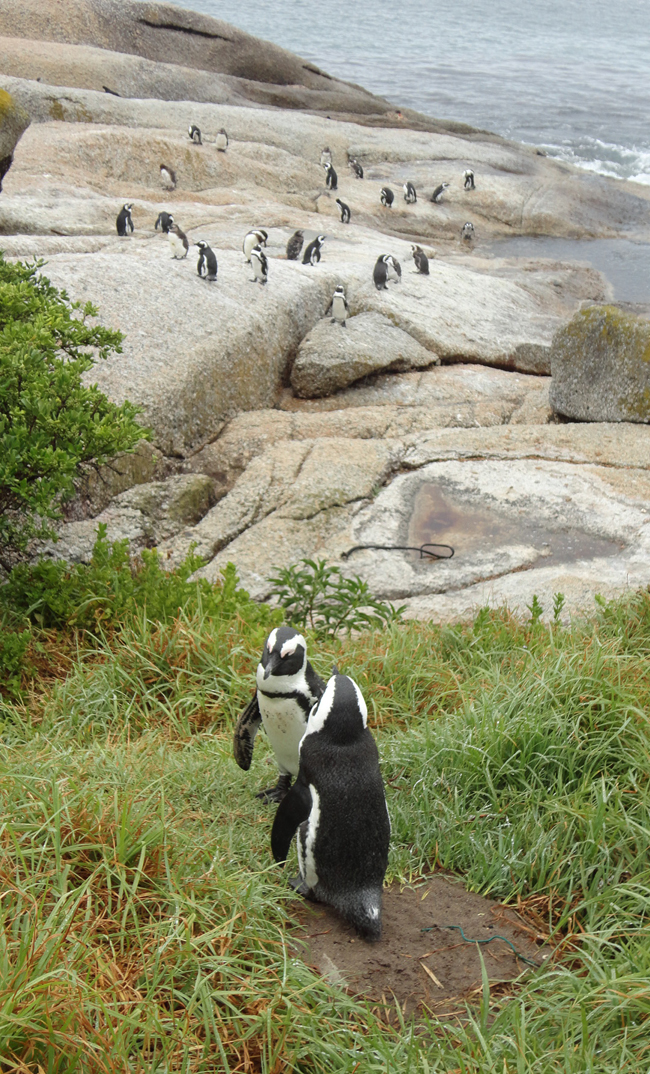

I like the phrase :…these strata were softened, stretched, and dismembered along the contact…”, although the florid writer might not have been a geologist. Most geologists would recognize that a member is a sub-unit of a formation and generally larger in size than the xenoliths in the outcrop. A better word than dismembered might be disintigrated, although broken-apart might be more appropriate for the location.
I first saw those formations in 1976! Only today did I learn what they are and how they were probably formed. Thanks.
As for the African Penguins, I guess you were the only visitor who focused on the rocks, rather than the birds.
🙂
I shot a short (2:39) video there in January. Some rocks are visible. You can see it at
http://www.youtube.com/watch?v=SBjsbPPGz1g&context=C323dc47ADOEgsToPDskJANg0okxDBTeZOaD5nwAM9
You’re welcome, Callan! It was a pleasure to take you and Lily around.
I came across this post while searching for articles about Sea Point. I’m not a geologist but I do find fascination with geological features. I’d like to know where exactly is this? Is it near Seacliffe Road in Sea Point?
I’m afraid I don’t know the address. It’s a small peninsula, maybe the 2nd or 3rd one on the right as you drive south from the Waterfront through Sea Point.